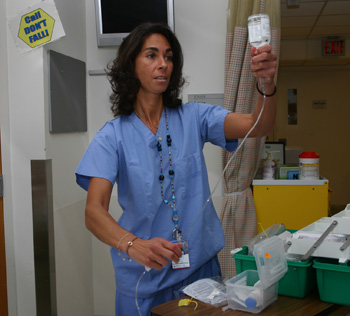Stroke Team Saves Lives

Kristin Lewis, RN, of the Neuro ICU, is ready to administer TPA to a stroke patient.
At a moment’s notice, Kristin Lewis, MSN, RN, CNRN, is ready to respond to a page for the Acute Stroke Intervention Team, report to a Tower patient care area and administer a life-saving dose of medication to a patient having a stroke.
Lewis is one of many nurses from the Neuroscience ICU trained to respond to these situations throughout the Tower. For the patient, the swift response of the physician and nurse on the Acute Stroke Intervention Team can be the difference between life and death.
Vince Vacca, MSN, RN, CCRN, nurse educator in the Neuro ICU, said, “The window to treat ischemic stroke with intravenous TPA is only three hours.” TPA is the only FDA-approved intravenous medication effective in treating this type of stroke, but it cannot be administered after three hours from the onset of symptoms—making a speedy response vital.
“Bedside nurses know their patients so very well and often are the people who get help in time,” said Shaun Golden, BSN, RN, CNRN, nurse manager of the Neuro ICU.
The Acute Stroke Intervention Team recently responded to a call on Tower 10B. Jill Dunleavy, RN, noticed her patient having trouble breathing and called a code SART (STAT Anesthesia/Respiratory Therapy Team) to examine the patient. Heidi Smith, RN, CNRN, nurse educator for Intermediate Neuroscience Care, recognized the patient was having a stroke and recommended the physician page the Acute Stroke Intervention Team.
“Thanks to Jill’s attentiveness and Heidi’s expertise, the Acute Stroke Intervention Team was able to respond quickly and administer a life-saving dose of TPA to the patient,” Vacca said. “All nurses should be aware of their patients’ baseline neurological status. If there is a significant change, a nurse should assume it’s a stroke until proven otherwise.”
Mobilizing the patient’s medical team is the first step to accessing this service. Once the patient has been medically assessed, a physician can access the Acute Stroke Intervention Team at beeper #31382 or by typing “Stroke Service” in the Partners Telephone Directory. The stroke MD on call will evaluate the patient and call the Neuro ICU for a nurse to assist and bring the clotbuster box, which holds the TPA. Patients are then transferred and monitored in the Neuro ICU.
For more information on the Acute Stroke Intervention Team, e-mail Vacca at vvacca@partners.org
| Know the Signs of Stroke
Symptoms of stroke include sudden changes in:
• level of consciousness or alertness
• muscle strength and control of limbs, e.g., leg or arm weakness or paralysis
• facial appearance, e.g., one side of face appears droopy
• ability to speak |